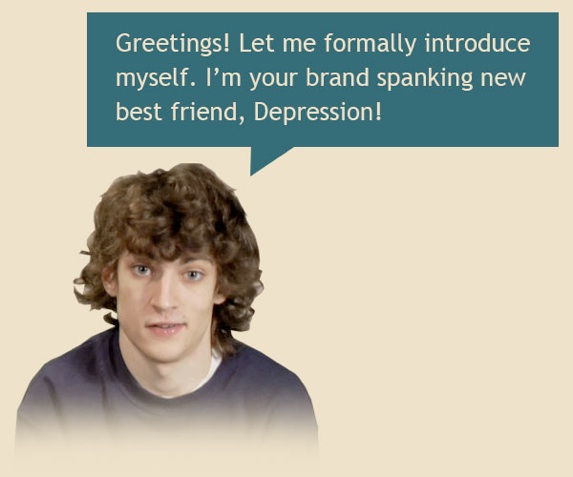Latest Public Service Radio Minute
Loss of EmploymentLoss of Employment, MP3, 1.3MB
Listen to or download all our PSAsSupport Our Work
Please donate so we can continue our work to reduce the stigma of psychiatric illness, encourage research, and support educational activities for behavioral health professionals and the public. Ways you can donate and help are on our Support and Donations page. Thank you!
More InfoLatest News Around the Web
Psychiatry Becoming More Collaborative, APA’s Binder Says
In her column in the Minneapolis Star Tribune (2/14), Gail Rosenbloom wrote that the University of Minnesota faculty members “are moving into the classrooms of first- and second-year” medical “students to tell them what it’s really like to be a psychiatrist” in “an effort to demystify the field and combat the stigma related to working with people living with mental illness” and to attract more students to the specialty. Explaining the advantages of becoming a psychiatrist, American Psychiatric Association president Renee Binder, MD, said, “Psychiatry offers a way of developing close relationships with patients.” What’s more, psychiatry “is becoming more collaborative, she noted, with mental health practitioners sharing office space with pediatricians, obstetricians and other disciplines.”
Related Links:
— “Rosenblum: In Minnesota, the push for more psychiatrists gets creative,” Gail Rosenblum, Minneapolis Star Tribune, February 14, 2016.
Bill Addresses Higher Suicide Rate And Mental Healthcare Needs Of Veterans
The San Diego Union-Tribune (2/14, Steele) reported “momentum in the battle against suicide” among veterans “with several bills pending in Congress.” One measure, “which applies to the US Department of Veterans Affairs, addresses the higher suicide rate among female veterans and the mental health care needs of vets privy to classified material.” Meanwhile, there is still ongoing “tension between medical privacy rights and family involvement.” Privacy between a physician and a patient “is a basic principle of medicine.” American Psychiatric Association president Renee Binder, MD, “said there are exceptions to confidentiality, including an emergency. But otherwise, the best a psychiatrist or therapist can do is encourage a patient to include loved ones, she said.”
Related Links:
— “Congress considers veteran suicide bills,” Jeanette Steele, San Diego Union-Tribune, February 14, 2016.
Panel Tells VA To Focus On Treatment, Not Causes Of Gulf War Illnesses
The Military Times (2/11, Kime) reports, “A scientific panel has concluded that the Veterans Affairs Department should stop searching for links between environmental exposures in the 1991 Persian Gulf War and veterans’ illnesses and instead focus on monitoring and treating those who have health problems related to deploying 25 years ago.” In their report, Institute of Medicine researchers “said Gulf War veterans are at increased risk for developing some physical and psychological health conditions like post-traumatic stress, anxiety, Gulf War illness and chronic fatigue syndrome, but other diseases like cancer, respiratory illnesses and most neurodegenerative conditions do not appear to occur at higher rates in these former troops.”
Related Links:
— “Panel to VA: Stop studying causes of Gulf War illnesses, focus on treatment,” Patricia Kime, Military Times, February 11, 2016.
CDC Data Indicate 8.4 Percent Of Women Smoke During Pregnancy
STAT (2/10, Thielking) reports that new data (pdf) from the CDC indicate that approximately “8.4 percent of women smoke during pregnancy, despite the risks for the developing fetus.” The agency “warns that smoking while pregnant raises the risk of premature deliveries, low birth weight, and certain birth defects.”
Related Links:
— “More than 8 percent of women smoke while pregnant, despite risks,” Megan Thinking, STAT, February 10, 2016.
Partisan Tensions Over Gun Control Emerge During Senate Committee Meeting On Mental Healthcare Reform Measure
The Hill (2/10, Sullivan) reports on “partisan tensions over gun control” that emerged yesterday during a meeting of the Senate Judiciary Committee while members took up a mental healthcare reform measure from Sen. John Cornyn (R-TX). Cornyn’s bill “seeks to increase treatment for” people with mental illnesses “as an alternative to imprisonment – a bipartisan goal.” Democrats, however, contend that “other sections of the bill would make it easier for” people with mental illnesses to “get guns.” Sen. Charles Schumer (D-NY) said, “That is the opposite direction from which we should be moving.”
Related Links:
— “Gun politics stymie mental health push,” Peter Sullivan, The Hill, February 11, 2016.
Foundation News
Nothing Found
It seems we can’t find what you’re looking for. Perhaps searching can help.

